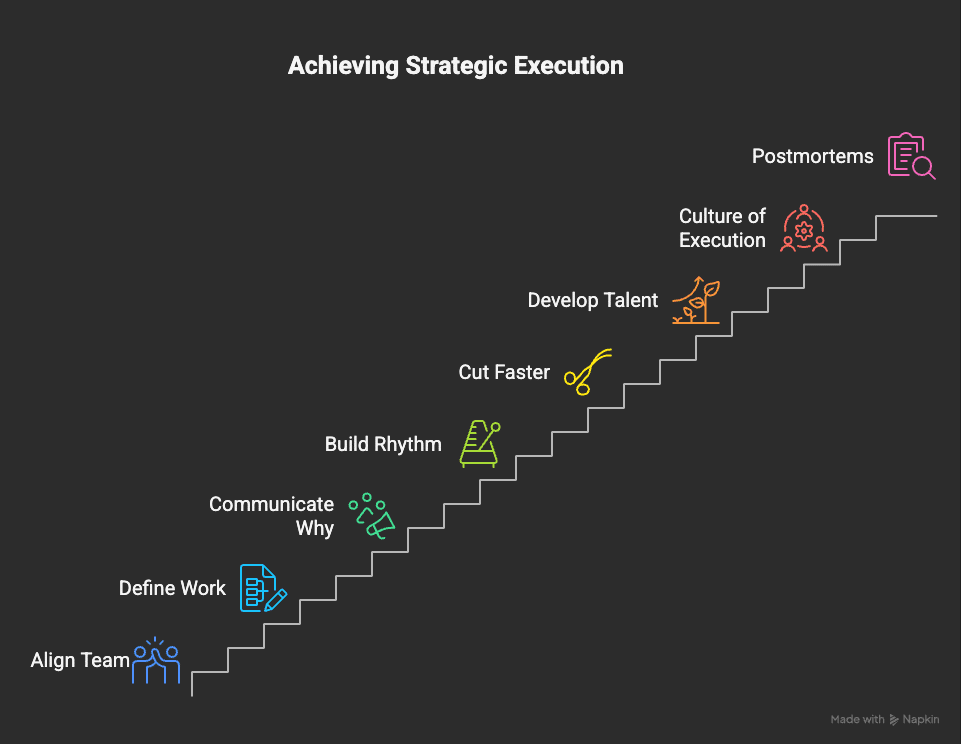Executing business strategy isn’t just about having a plan—it’s about translating that plan into action. Many leadership teams invest significant time crafting strategic visions, only to falter during execution. The result? Misalignment, stalled initiatives, and teams disconnected from the overarching goals.
At Champion PSI, we’ve guided executive teams through various strategic challenges. One consistent insight: execution isn’t about working harder; it’s about moving smarter.
In this blog, we’ll delve into 8 decisive power moves that transform strategy into tangible results and how you can implement them immediately. If you’re seeking elite coaching support while executing business strategy, explore our top executive coaches to accelerate growth.
Overview: Why Executing Business Strategy Fails—and How to Fix It
Executing business strategy demands more than ambition. It requires rhythm, clarity, and relentless follow-through. Failures often stem from the assumption that strategy execution naturally follows planning—it doesn’t.
Here are the 8 power moves that drive real progress:
- Align Your Executive Team First
- Define the Work Behind the Strategy
- Overcommunicate the “Why”
- Build Rhythm and Cadence
- Cut Faster Than You’re Comfortable
- Develop Execution Talent at Every Level
- Treat Execution Like a Culture, Not a Checklist
- Run Postmortems Without Ego
These moves differentiate a strategy confined to a slide deck from one that delivers measurable outcomes.

Power Move #1: Align Your Executive Team First
If your leadership team lacks clarity on the strategy, the rest of the organization will too. Executing business strategy begins with a unified leadership perspective—on objectives, terminology, and success metrics.
Misalignment at the top cascades into confusion below.
Utilize strategic planning models to clarify direction and foster team-wide commitment. Explore this guide on creating a strategic plan for practical steps. Establish early on that execution is a collective responsibility. You can also reference these CEO performance insights from McKinsey to assess and align leadership effectiveness.
Power Move #2: Define the Work Behind the Strategy
A strategy without an execution plan is merely wishful thinking. Deconstruct your strategic goals into operational objectives, then delve deeper:
- What specific actions will each team undertake?
- What are the immediate priorities?
- Who is accountable, and who provides support?
Implement cascading Objectives and Key Results (OKRs) to bridge top-level strategy with daily operations. Equip leaders with tools to measure progress, not just direction.
Power Move #3: Overcommunicate the “Why”
Strategies often falter because teams don’t grasp the underlying purpose. Executing business strategy necessitates more than periodic updates—it requires continuous interpretation.
Communicate in relatable terms, not corporate jargon.
Connect strategy to core values. Illustrate how individual roles contribute to overarching goals. Reinforce messages across various channels—town halls, one-on-ones, internal communications, and daily meetings.
When strategy becomes part of the organizational language, it drives action.
Power Move #4: Build Rhythm and Cadence
Strategies stagnate in organizations operating in sporadic bursts. If evaluations occur only quarterly or annually, you’re already behind.
Establish a consistent accountability rhythm:
- Monthly leadership execution reviews
- Weekly team progress assessments
- Bi-weekly cross-functional meetings
Consistency fosters momentum, and momentum builds confidence.
Power Move #5: Cut Faster Than You’re Comfortable
Execution isn’t solely about initiating new projects; it’s about discontinuing ineffective ones.
Organizations often carry strategic burdens—outdated projects, redundant tools, or unnecessary meetings. Without active pruning, these elements obstruct progress.
To facilitate execution, eliminate distractions.
As Peter Drucker aptly stated: “There is nothing so useless as doing efficiently that which should not be done at all.”
To avoid the common traps, this post on scaling challenges solutions can help.
Power Move #6: Develop Execution Talent at Every Level
Executing business strategy isn’t a top-down endeavor. It materializes within departments, teams, and frontline interactions.
Hence, coaching becomes indispensable.
Leaders must cultivate internal coaching capabilities, enabling managers at all levels to support execution clarity. Otherwise, success hinges on chance. As Forbes outlines in its breakdown of executive coaching potential, these partnerships clarify vision and boost decision-making.
For a more structural approach, review Harvard Business Review’s guide to a successful leadership development program, and tie it back to Champion PSI’s own leadership development principles.
Power Move #7: Treat Execution Like a Culture, Not a Checklist
Many organizations attempt to enforce strategy through metrics. However, execution flourishes when it’s ingrained culturally, not just procedurally.
Reflect on:
- Do we celebrate progress, not just outcomes?
- Do we incentivize cross-functional collaboration?
- Do we discuss execution as part of our identity?
When execution becomes intrinsic to your organization’s ethos, you transition from managing strategy to embodying it. See how BCG fosters strong executive coaching partnerships to sustain long-term alignment.
You can also develop execution culture by examining the characteristics of a strong team that scales.
Power Move #8: Run Postmortems Without Ego
Execution maturity is evident after project completion. Elite teams distinguish themselves in this phase.
Conduct debriefs for every significant initiative:
- What succeeded?
- What fell short?
- What lessons will inform future endeavors?
The objective isn’t to assign blame but to gain clarity. Postmortems foster shared learning and reinforce a culture of continuous improvement.
Real-World Example: How Zara Executes Strategy at Speed
Zara, the flagship brand of Inditex, has revolutionized the fashion industry with its rapid strategy execution. Unlike traditional retailers that plan collections months in advance, Zara’s agile supply chain enables it to move from design to store shelves in as little as two weeks.
Key elements of Zara’s execution strategy include:
- Vertical Integration: Controlling most of its supply chain allows Zara to respond swiftly to changing fashion trends.
- Real-Time Data Utilization: Store managers relay customer feedback directly to designers, ensuring collections align with current demand.
- Limited Production Runs: By producing smaller quantities, Zara creates a sense of urgency among consumers and reduces excess inventory.
This approach has positioned Zara as a leader in fast fashion, showing how execution speed and customer proximity can drive market dominance.
FAQs: Executing Business Strategy
What is executing business strategy, exactly?
Executing business strategy involves translating high-level goals into actionable steps that are owned, tracked, and delivered across the organization. It’s about moving from vision to tangible results.
Why do so many strategies fail in execution?
Common pitfalls include lack of alignment, poor communication, and inconsistent follow-through. Often, teams don’t fail due to flawed strategies but because of inadequate execution frameworks.
How do I measure if my strategy is being executed well?
Monitor early indicators such as team clarity, milestone progress, and cross-functional alignment. Look for building momentum, not just completed reports.
Who owns strategy execution?
While everyone plays a role, the executive team holds primary responsibility. Leaders must champion both the development and implementation of strategies.
Can coaching really help with strategy execution?
Absolutely. Coaching enhances clarity, accountability, and leadership agility—all vital for navigating the complexities of execution. Gallup’s model for strengths-based leadership emphasizes the lasting power of this approach.
Executing Business Strategy Requires These 8 Power Moves: Conclusion
Executing business strategy is the true test of leadership. Crafting a plan is one thing; driving it through resistance, complexity, and change is another.
The 8 power moves outlined—alignment, clarity, cadence, communication, culture, pruning, talent development, and reflection—aren’t magic solutions. However, collectively, they establish a framework that supports sustained progress.
Ready to get started?
Book a free 30-minute call with an expert coach to explore how executing business strategy can support your goals.










